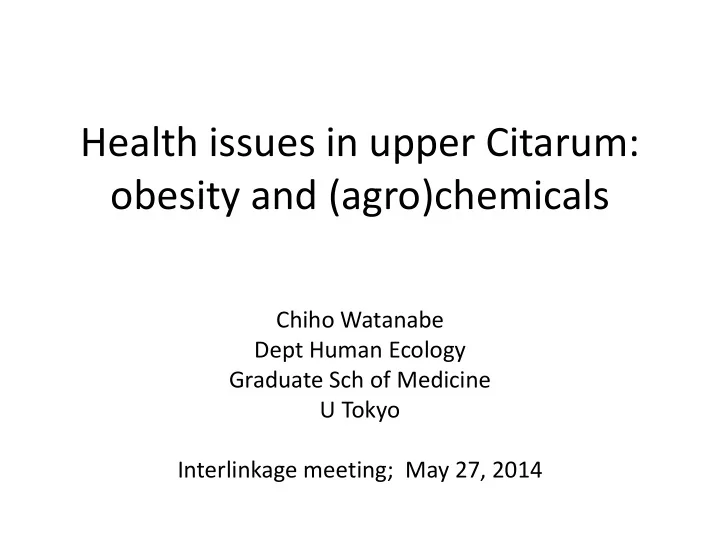

Health issues in upper Citarum: obesity and (agro)chemicals Chiho Watanabe Dept Human Ecology Graduate Sch of Medicine U Tokyo Interlinkage meeting; May 27, 2014
Profile of ENVrionmental REsearch in Rural Asia 2006-2009 • Bangladesh, China, Indonesia, Nepal, PNG, Vietnam approx. 5,500 participants from 32 rural communities (some “urban” included as the “control”) • focus: - Impact of the changing lifestyle (changing subsistence) on health (and environment) in rural Asia > communities were so selected to reflect different lifestyle within each area. - Exposure to (Agro)chemical, industrial chemicals, and metals among villagers. - nutritional status (including lean/overweight) among adults (“Double burden”) • household survey in Upper Citarum. -5 villages: 50 households/village with schoolchildren - Sampling of biological media (blood, urine, saliva) - Interview: demographic, socioeconomic status, food consumption, physical activity (GPS/accelerometer). * Collaboration with Institute of Ecology, UNPAD for West Java survey.
Subsistence transition and life/health Pop. In Asian developing countries : total/rural ( 3.6/2.2 bil ) (FAO, 2000) Traditional agriculture Effects on life/health ・ chemical exposures ⇒ Self-consuming, sustainable, domestic biomarkers of effects slush-and-burn (tuber), paddy field ・ shortened ? Labor hours Chemicals: pesticides, ・ improved food, nutrition subsistence Fertilizers, food additives, transition Effects on Plastics, undegradables local environment Cash crop-oriented ・ introduction of agriculture chemicals ⇒ water quality, products, Market-dependent, risk-taking ・ changes in the land usage Adopting new technology, incld chemicals ( forest converted into Vegetables/coffee/tropical fruits cultivating field ) banana/rubber 2008
Study sites B= agri culture to pisciculture (Sagulin 1985) pop 8,034 HH 2,133 (2001) C= vegetable & dairy Agriculture activity = low farming 1,200-1,600 m ASL pop 5,070 HH1,300 (2002 ) Agriculture activity = high P= paddy-field & cash- crop 950-1,450 m ASL Pop. 9,555 HH 3,200 (2002)
C (agricultural) B (pisciculture) P (control)
Examples of the Effect variables ( Z) nutritional status and stress B C T P S 1way A y ANOVA Hb [g/dL] ♂ 13.9 14.2 15.0 13.9 14.2 ** ( NOT adjusted for ♀ 12.8 13.2 13.5 12.7 12.2 *** altitude ) ♂ 721 433 632 645 409 * Uinrary Zn [ μg/gCre] ♀ 499 484 430 389 298 ns ♂ 34 21 30 25 21 *** Urinary Se [ μg/gCre] ♀ 35 25 30 21 22 *** ♂ 159.7 159.8 161.2 159.6 160.7 ns Height [cm] ♀ 149.3 147.6 150.9 149.1 150.0 * ♂ 21.3 20.8 21.3 20.5 21.7 ns BMI ♀ 24.1 23.2 24.8 22.6 24.2 * ♂ 17.3 16.5 17.0 16.8 19.4 ns %fat ♀ 35.4 33.8 35.4 32.9 35.8 ns ♂ 25.5 25.7 26.7 24.8 26.6 ns MUAC ♀ 27.8 25.8 28.0 25.1 27.0 * ♂ 1.3 1.9 1.4 1.6 1.4 * Salivary cortisol [ng/mL] ♀ 1.4 2.1 1.9 1.7 1.3 *
Exposure to chemicals B C T P S ANOVA VA Spraying ♂ 4 65 31 10 4 *** Pesticides ♀ 2 0 0 0 5 ns % ( Q42 ) ♂ 3.9 4.0 4.4 4.3 4. 1 *** Ac h E/Hb ♀ 3.4 3.6 3.9 3.6 3.5 ** ♂ 50 57 64 31 56 * Urinary DAP [ % detected ] ♀ 38 31 49 23 49 ns ♂ 75 80 83 81 61 ns Urinary As [ ng/mgCre] ♀ 88 101 76 76 63 ns ♂ 0.93 0.41 0.68 0.83 0.65 * Urinary Cd [ ng/mgCre] ♀ 1.61 1.06 0.94 0.70 0.69 *** ♂ 5.5 2.9 3.8 1.5 1.5 *** Urinary Pb [ ng/mgCre] ♀ 5.5 2.3 3.7 1.2 1.6 ***
Relationship between effect (Z) and descriptor (Y) “nutritional status” domain – PC1 = “high energy” status FEMALES MALES S ( urban ) S ( urban ) B ( fish ) T ( dairy ) P ( paddy ) C ( vege ) MALES = high only in S (urban) FEMALES = high in B , T in addition to S . PC1 load : females > males ( partly due to higher %fat ). non-farming, & chem-dep farming were associated with “high energy”
Effects (Z) and descriptors (Y): stress (physical/psychological) males females S ( urban ) T ( dairy ) C ( vege ) B ( fish ) P ( paddy ) Saslivary cortisol concentration; would reflect both physiological psychological stresses . Both non-farming¥chem-dep farming >> lower stress
Obesity (risk for chronic dis.) BMI males BMI females Under Over Under Over N mean N mean (<18.5 ) (>25 ) (<18.5 ) (>25 ) West Java, Indonesia Vairous area, Nepal ESA Human Ecology: SYMP-19 @Pittsiburge 100805
GPS/accerelometer plot of an individual 11
ENVRERA West Java lifestyle change and health; findings • Most of the health-associated variables showed inter- community difference, some (e.g. nutrition) were positively and others (e.g., stress) were negatively associated with “urban” characteristics. • Substantial proportion of lean and overweight individuals were observed within each community. “Fat females and lean males” was the predominating pattern; a feature of West Java population (among the six countries surveyed). This indicated the impacts of “lifestyle change” may not be identical on males and females. • Exposure of children to agrochemical (organophosphate pestides) were less extensive compared to that of children living in a rural area in Japan, and the levels were not associated with the intensity of agricultural activity. While exposure to metal elements like Cd and Pb did not seem extensive, the level of As was somewhat elevated.
Recommend
More recommend